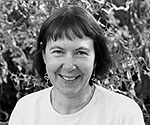Degree(s): BA, PhD, DSc (all from the University of Cambridge)
Graduate School: University of Cambridge, Cambridge, UK
Undergraduate Institution: University of Cambridge, Cambridge, UK
Current Position/Univ.: Professor of Physiology, University of Oxford, Oxford, UK

I grew up in the wilds of Dorset, England, where the beautiful countryside stimulated an abiding interest in the natural world. I spent most of my childhood rambling about the countryside searching for wild orchids, bird watching, badger watching, and exploring rock pools. I read voraciously, anything and everything, not just books about science, but also novels and poetry. I think the thing that drove me into science was plain curiosity - I just wanted to understand how things work.
I went to University in Cambridge, where I read Natural Science and remained there to do a doctorate in Zoology. After short periods at Leicester and Los Angeles, I moved to Oxford where I was appointed to a Lectureship in Physiology in 1990 and to a Professorship in 1996. In 1999 I was elected as the 8000th Fellow of the Royal Society of London (one of the few women Fellows). The joy of a life is science is its freedom and its enormous diversity. From the very first, I was encouraged to have my own ideas, and to follow them through. The range of things I spend my days doing is enormous: peering down microscopes, fixing electronics, writing, lecturing, reading, travelling (this year I will give talks in France, Austria, United States, Germany, New Zealand, Australia, UK, Italy and Denmark), teaching, playing with all kinds of wonderful equipment, and talking - always talking with colleagues both in the lab and all over the world about ideas.
I divide my time between scientific research, teaching medical students, writing books and fundraising. I've written over 120 research papers and three books - two textbooks and one book for the general reader (Life at the Extremes, about the science of human survival, published by Harper Collins). I am also very interested in the relationship of science with literature and the visual arts, and I recently produced an exhibition with the artist Benedict Rubbra about the different ways that artists and scientists view the world.
For more information on Frances Mary Ashcroft, see:
- Ashcroft's book, Life at Extremes
![[email]](./gif/menue.gif)

